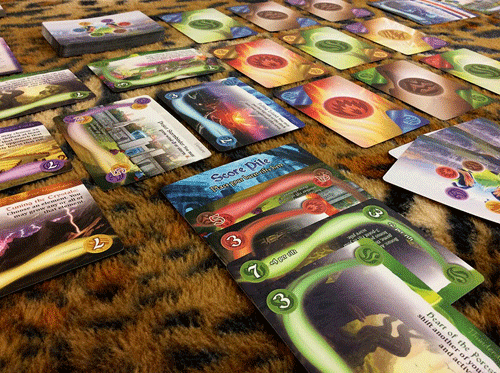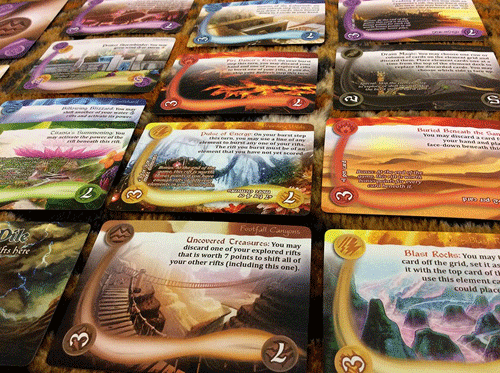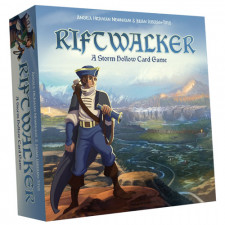Riftwalker: A Storm Hollow Card Game Review
on Jan 12, 2017
What a brilliant idea: mix the varied card abilities and addictive combo-building of Magic: The Gathering with the simplicity of tic-tac-toe. Like Storm Hollow, the much-delayed kid-friendly RPG set in the same universe as Riftwalker, it promised to combine a beloved geeky pastime with family-appropriate art and mechanics.

The colorful art redeems the title a little bit, but it's probably better to wait for Storm Hollow.
When it comes to delivering on promises, designers Angela Hickman Newnham and Julian Leiberan-Titus are 0 for 2 so far. Storm Hollow is still off on the distant horizon, and Riftwalker...well, it gels about as much as you'd expect from a game about walking between dimensions.
Basic gameplay revolves around "using" an element in a grid of nine double-sided cards, either by flipping the card over so that it shows a new element or by bringing a new element into the world by replacing a card with the top card of the element deck. Once you've used an element, you may "explore" a matching rift from your hand, placing it in front of you, or shift a previously explored rift, making it worth more points when scored. In either case, you then activate that rift's special ability, which could let you manipulate the grid, shift or play something else, or perform a special action to gain bonus points. At the end of your turn, if there is a three-in-a-row of a single element in the grid, you can "burst" a rift of that element, adding it to your score pile (this is the tic-tac-toe part). The art is colorful and evocative, along with the area names on the rift cards (places like Starfall Deeps, Weirding Wilds and Quizzleplex), but the complexity of the card abilities clashes with, rather than complementing, the simplicity of the elemental grid.

The card abilities and area names are varied—perhaps a little too much.
Not that making a three-in-a-row by flipping cards is necessarily simple. Some cards allow you to swap the position of two cards in the grid, while others let you "grow" an element to bring out a face-down color, but lining up the cards for those bursts is usually a long, complicated process that isn't made any easier by the fact that other players might be actively trying to impede you, or at least pursuing their own agendas. When you consider that you have to first explore and then shift a rift before you can burst it, it's a wonder it ever happens at all. Which is sort of not good when bursting rifts is what triggers the end of the game. They may take only a half hour or so, but games of Riftwalker always feel as though they're lasting too long.
Players can hold three rift cards in hand at once, and while the rare combo might entice you to hold on to your cards turn after turn, that strategy can run out of gas pretty quickly if the element grid isn't cooperating, so many turns are spent "hand cycling" looking for the better cards. With the exception of some multi-element ones, every card is worth either 3 or 7 points, depending on how far they're shifted, but some are worth bonus points—in addition to their special ability—which makes the ones that aren't look like good discard-fodder in comparison. And some cards just feel strictly better than other, similar ones: one fire card forces you to burn explored rifts, while another lets you burn cards directly from your (frequently replenished) hand, with identical point bonuses for each such action.
The hand management, on top of the frustrations of the element grid and the unbalanced-feeling rift abilities, makes this feel less kid-friendly than it could have been, strategy-wise. It's a brilliant idea missing a brilliant game.

 Customer Support
Customer Support  Subscribe
Subscribe 




 Account
Account  Wishlist
Wishlist 

